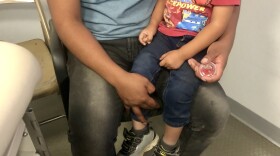A large white tent-like structure sits next to the Donna-Rio Bravo International Bridge in Texas’ Rio Grande Valley on the U.S.-Mexico border.
In recent months, the Department of Homeland Security has been dealing with an influx of unaccompanied minors and family units from Central America arriving at the southern border.
DHS recently announced the agency will expand its border detention facilities in Texas with the opening of two new tent-like structures, which were completed this week.
Media gathered inside the 40,000 square foot facility, which is nearly the size of a football field, in Donna for a press briefing and tour.
https://youtu.be/h2qrUXgmM4U
Executive Officer Carmen Qualia of Border Patrol led the tour.
“What you are in right now is what we refer to as a pod -- one of four detention pods -- and the pods are approximately 8,000 square feet,” said Qualia.
Qualia said the pods are also color coded.
Migrant families and unaccompanied children are supposed to be detained at the facility for no longer than 72 hours.
“We also have an intake area and a processing area, and you’ll be able to see that intake. It’ll be the next location that we go and see,” Qualia said.
The pod had high ceilings with tarp-like walls and was nearly empty. Stacks of thin-black plastic mattresses were pushed up against one wall.
The facility is meant to hold 500 people but could hold even more if necessary. Qualia said the facility was needed.
“I hope it’s enough. I hope it’s enough,” she said. “We would like the flow to slow down and stop all together.”
A public information officer with the agency took media from the pod to the intake center, where there were rows of black benches and border officials behind computers.
At the intake center there were also doors that lead to the shower area.
“There’s 36 showers, 18 for the females and 18 for males, and they drain in the middle,” the public information officer said.
The structure was one of two new tent structures built to detain migrants when they are apprehended at the border or turn themselves in to border officials. The other facility is in El Paso.
The structures are part of a $36.9 million contract awarded to Deployed Resources LLC, a New York company chosen to construct the facilities.
Across the southern border, more than 103,000 migrants were taken into custody in March — the biggest monthly total seen in more than a decade. The Border Patrol reported apprehending more than 30,000 migrants in the Rio Grande Valley sector in March.
Rick Morales, Donna’s mayor, welcomed the facilities.
“We as small cities are not equipped to handle two, three, four thousand people coming over, and we don’t have those kinds of funds,” he said.
The new tent structures will be temporary and have a four-month base period with four one-month options. Morales said they need more.
“I think they need maybe 2,500 beds, 3,000 beds,” said Morales.
Morales added that it’s important to treat the arriving migrants humanely.
“We have to do the right thing. We’re America. If we turn these people away and not take care of them properly, where else will they go?” he asked.
The temporary holding facilities aren’t new for Donna. In late December 2016, during the final days of the Obama administration, a similar facility opened in the city, but it was only operational for a couple of weeks.
Back then, the detention center raised concerns among residents, immigration advocates and community leaders.
Carlos Moctezuma Garcia is an immigration attorney in the Rio Grande Valley. Garcia said in 2016 migrants didn’t have access to legal representation at the holding facility, and he’s worried that same thing will happen this time.
“This is the first contact they’re having with law enforcement officials, and the information that they give here can later be used in whatever court proceeding that these people are going to have,” Garcia said.
Garcia was also concerned about oversight and accountability issues that may arise and migrants’ access to medical care, which has historically been an issue at detention facilities.
An ACLU report from 2014 found another tent structure in Texas, which was managed by a private prison company, had problems with bug infestations in the sleeping quarters, overcrowding, sewage overflows, extreme temperatures and spoiled food.
In the end, Garcia said he’d like to see border officials find alternatives to detention.
“The majority of these people are presenting themselves to a border patrol official as soon as they see them. Why? Because they want help. They’re not looking to evade. So that to me tells me they will continue showing up to immigration court,” he said.
The agency said migrants detained in these facilities will be released under 72 hours either to Immigration and Customs Enforcement or, if they are unaccompanied minors, to Health and Human Services for placement in a shelter or with sponsors.
CBP said they don’t provide legal services to migrants at the temporary holding facility because the facility is not meant for long-term detention.
The first migrants were expected to arrive on Friday.
Reynaldo Leaños Jr. can be reached at Reynaldo@TPR.org and on Twitter at @ReynaldoLeanos
Copyright 2020 Texas Public Radio. To see more, visit Texas Public Radio. 9(MDAxODQzOTgwMDEyMTcyNjI4MTAxYWQyMw004))







